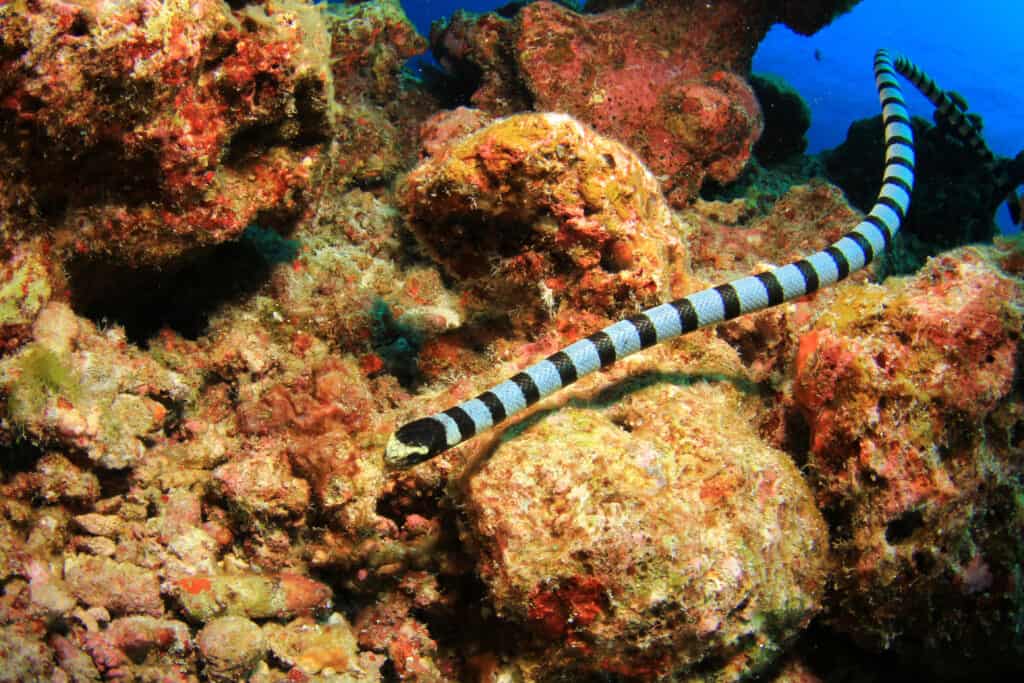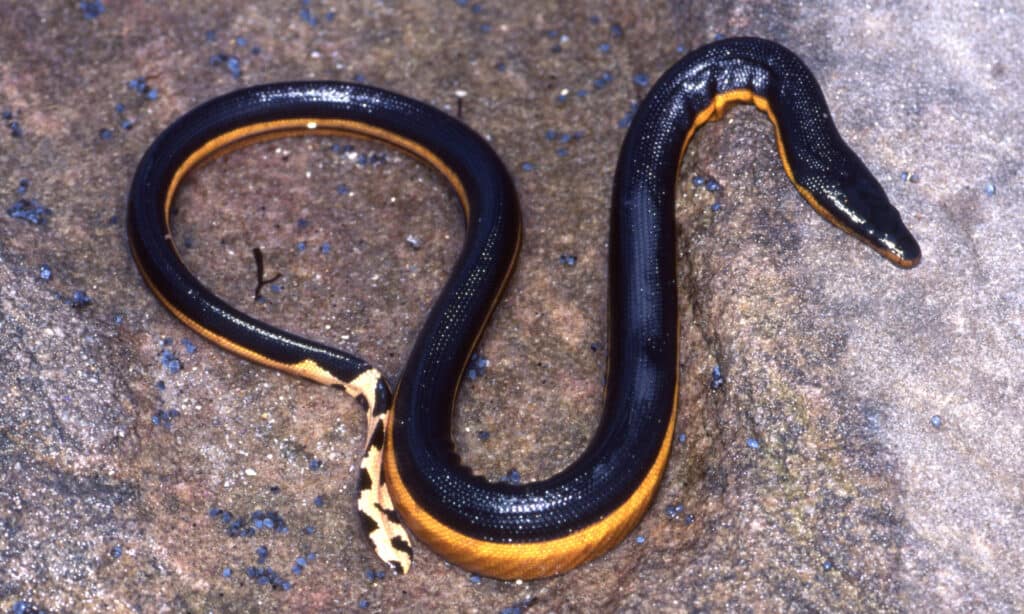Sea snakes are some of the most amazing creatures on earth, but they also have a reputation as deadly killers. Although they only live in certain parts of the world, they are well-known where they can be found! Today, we are going to learn a bit more about these snakes and what makes sea snakes so deadly. By the end, you’ll know if you should worry about sea snakes, plus what makes them so dangerous. Let’s get started!
What defines a Snake as a “Sea” Snake?

Sea snakes are grouped into two subfamilies: Hydrophiinae and Laticaudinae.
©Rich Carey/Shutterstock.com
Snakes are some of the most common animals in the world. They live on every continent besides Antarctica, come in nearly limitless colors, and can be extremely dangerous or totally harmless. There are over 3,000 recognized species of snake globally, with about 7% of those being venomous. Additionally, many snakes live in a variety of habitats, including the ocean. As far as sea snakes go, is being able to enter the ocean all that it takes to be classified as a sea snake? Not quite.
To be classified as a sea snake, a snake needs to be grouped in one of two subfamilies: Hydrophiinae and Laticaudinae. Sea snakes are almost always found in saltwater, although there are three species of snake found in freshwater. Overall, there are 69 species that can be placed into seven distinct genera.
Are all Sea Snakes deadly?

Almost all sea snakes are venomous, save for one small genus.
©Sahara Frost/Shutterstock.com
As a general rule, sea snakes are extremely venomous. In fact, all species of sea snakes are venomous, with the exception of the Emydocephalus genus. Emydocephalus is a group of sea snakes that have a unique diet that is comprised exclusively of snake eggs, making venom useless for most of the species.
Outside of the small Emydocephalus genus, sea snakes can generally be considered to be among the most venomous snakes in the world. Both subfamilies fall under the Elapidae family, otherwise known as elapids. Other notable elapids include adders, cobras, mambas, coral snakes, and kraits.
Sea snakes have neurotoxic venom. Neurotoxic venom is a powerful venom that often immobilizes prey and shuts down important bodily functions, especially when it comes to breathing and muscle movement. The most common symptoms of sea snake bites include headache, a thick-feeling tongue, thirst, sweating, and vomiting. After these initial symptoms, late-stage symptoms include progressive paralysis, starting with the eyelids, and paralysis of voluntary muscles.
What are the most dangerous sea snakes in the world?

Venom from the Belcher’s Sea Snake is so toxic that a single bite can kill a human being in less than thirty minutes.
©SaltedLife/Shutterstock.com
Although most sea snakes are highly venomous, there are a few notable examples that stand out. Traditionally, the most dangerous sea snake recognized was Hydrophis belcheri, otherwise known as the faint-banded sea snake or Belcher’s sea snake. Hydrophis belcheri has a toxicity rating of 0.24 mg/kg.
Hydrophis belcheri is extremely venomous, but recent studies show that a different sea snake is actually the most dangerous, contrary to what was popularly thought. Aipysurus duboisii, otherwise known as Dubois’ sea snake or the reef shallows sea snake, is now recognized as the most venomous sea snake globally. These snakes feed on eels and have an LD50 rating of 0.044 mg/kg. With such a rating, Aipysurus duboisii comes in as the third most venomous snake in the world, behind the inland taipan and the eastern brown snake.
Do Sea Snakes Attack Humans?
As we’ve seen above, sea snakes are some of the most deadly snakes in the world when it comes to venom ratings, but thankfully, that isn’t the only metric. Although sea snakes are venomous, they are extremely hesitant to bite and rarely inject humans, even when they do.
Belcher’s sea snake, for example, is one of the timidest venomous snakes around and would only bite a human if it was in extreme distress. Generally, humans are only bit by sea snakes due to fishing accidents. As fishermen troll oceans with nets and pull them aboard, they occasionally catch snakes. As one could imagine, a snake being pulled up in a net and then grabbed would be in a pretty bad mood.
Despite their venom, sea snakes prefer to avoid humans and don’t bite unless provoked. In fact, decades often pass without a single reported death from a sea snake bite.
Where do Sea Snakes live?

Yellow-bellied sea snakes are the only sea snakes found in the western hemisphere, but their arrival is rare and accidental.
©Ken Griffiths/Shutterstock.com
If all this talk of sea snakes is worrisome, it may be helpful to know that sea snakes are relegated to a somewhat small portion of the world. Both subfamilies of sea snakes are exclusively found in warm tropical waters in the Indian Ocean and in the Western Pacific Ocean.
Sea snakes don’t live in the Atlantic Ocean and aren’t found in the portions of the Pacific past the islands near Australia.
Do Sea Snakes live in the United States?
Sea snakes aren’t native to the United States, although one or two will occasionally wash up in Hawaii from islands near Australia. The only sea snake that is ever sighted near Hawaii is the yellow-bellied sea snake, although it is extremely rare.
The photo featured at the top of this post is © Nobu Tamura (http://spinops.blogspot.ca/) / Creative Commons – License / Original
Discover the "Monster" Snake 5X Bigger than an Anaconda
Every day A-Z Animals sends out some of the most incredible facts in the world from our free newsletter. Want to discover the 10 most beautiful snakes in the world, a "snake island" where you're never more than 3 feet from danger, or a "monster" snake 5X larger than an anaconda? Then sign up right now and you'll start receiving our daily newsletter absolutely free.
Thank you for reading! Have some feedback for us? Contact the AZ Animals editorial team.






